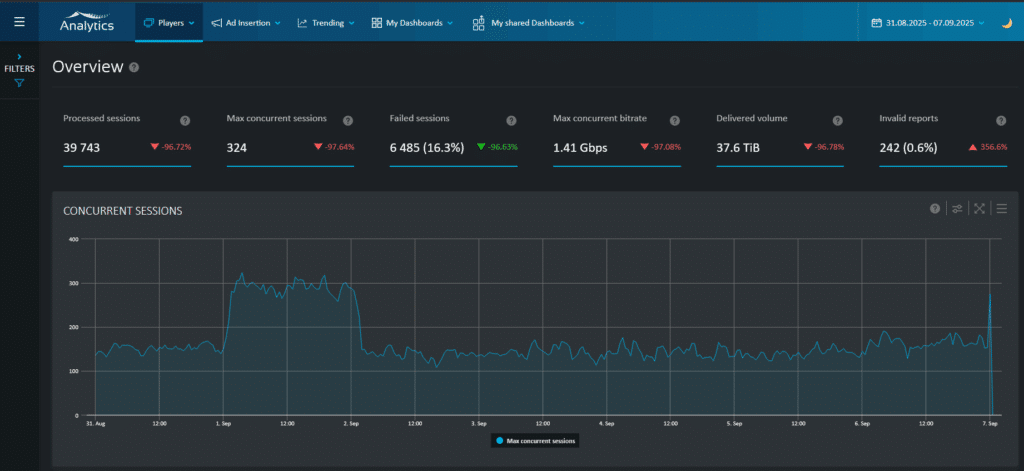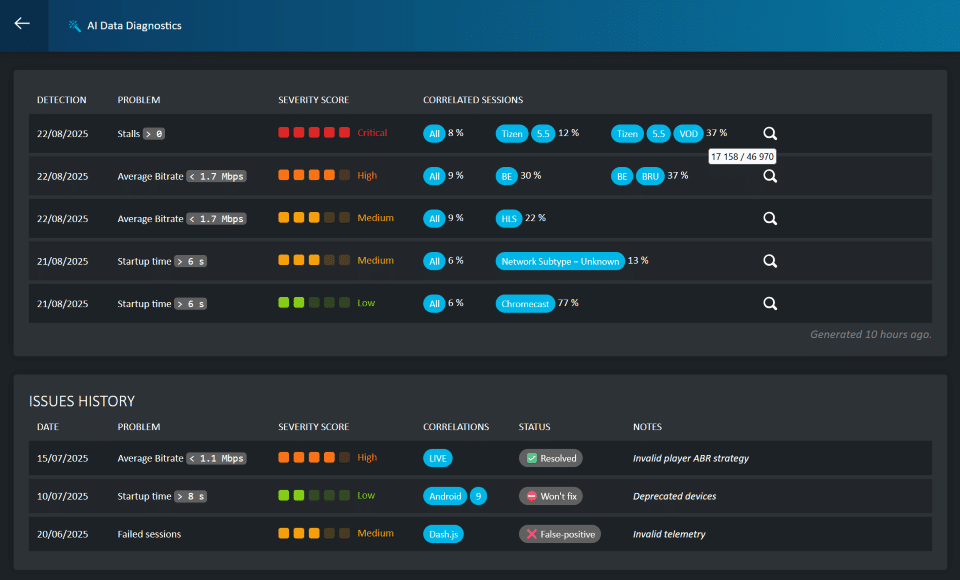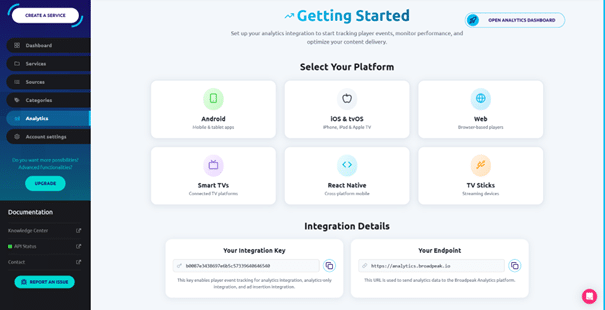We’re thrilled to introduce the beta launch of broadpeak.io’s Player Analytics as a Service (PAaaS). This solution uniquely combines delivery analytics and player-level QoE insights into our SaaS platform, offering a new level of understanding and control over your streaming performance.
Built on the proven Broadpeak analytics engine and SmartLib player SDK, PAaaS provides a comprehensive view of your streaming performance, from CDN delivery to playback on the viewer’s device, all in real-time.
We believe that this new service will help any streaming provider move beyond partial visibility, enabling faster troubleshooting, proactive issue detection, and better decision-making to optimize user experience. And it will do so in a price-conscious manner, including options to export the data if you wish to exit the platform.
Why we built it
If you have followed Broadpeak for a few years, you probably know that we do not develop only streaming engines. We also propose solutions to help our customers analyze the quality of their video experience.
The solutions are mainly based on two components: the Broadpeak Analytics engine on the server side (acting as a report ingestor/processor and a GUI), and the BPK SmartLib® (which is an SDK to be deployed client-side).

We built them because today’s streaming services typically can access either network-level telemetry (e.g., CDN statistics) or player-level metrics (e.g., startup time, buffering, ad events), but rarely in a single, coherent view. This makes it challenging to identify trustworthy sources of issues, compare performance across CDNs or devices, and measure the actual impact of changes.
We have noticed that some of our customers are struggling with their analytics. Whether they faced data quality issues, difficulties with interpreting numbers, or problems with privacy, integration, or actionability (to name a few), we recognized that we could provide a more universally accessible solution.
Enter Player Analytics as a Service, where we bring the world of the server and the client together in one service. By combining Broadpeak Analytics engine’s delivery-level data with SmartLib’s client-side measurements, you get a single source of truth for Quality of Experience (QoE) and Quality of Service (QoS).
What you can do with PAaaS
There are multiple benefits from using the service:
- See the whole picture: Understand how network performance impacts playback quality. Let’s not have any more blind spots.
- Measure in real time: Monitor startup time, buffering ratio, bitrate switches, ad starts/completions, and more.
- Evaluate precisely the experience of your viewers: with our satisfaction score, you can measure QoE, identify potential churners, or conduct targeted retention campaigns
- Run A/B tests: Compare different CDNs, configurations, or player versions to identify those with a real, measurable impact.
- React instantly: Receive alerts when metrics exceed defined thresholds, allowing you to act and resolve the issue.
- Optimize ads: Track ad events and completion rates to ensure monetization isn’t hurting the viewing experience.
On top of all that, fundamentally, PAaaS has been built leveraging AI technologies. We run AI to analyze the video streaming sessions of our customers. It helps with automatic data quality and integrity validation, as well as the Identification of Anomalous events.

How it works
1. Broadpeak Analytics engine. Collects and analyzes delivery metrics from your streaming infrastructure, including CDN performance, error rates, and geographic breakdowns. The engine is different from other video analytics portals for a few reasons:
- It offers a clean, modern UI that’s intuitive even for non-technical users. Navigation is smooth, visuals are clear, and key metrics are instantly visible. Operators and marketing teams can hop into the analytics portal without months of training.
- Users can build tailored dashboards for each use case (e.g., live, VOD, ads, multicast ABR). Widgets enable graphs such as PoP load, session creation per server, QoE metrics, and ad performance. Filters and exports (CSV, PDF) are supported for team-specific insights.
- The dashboards update live with metrics like session count, error rates, QoE trends, and PoP performance—and administrators can define thresholds to trigger alerts. This front-end-first approach means teams see issues and respond immediately.
- The module serves diverse teams:
- Marketing can monitor adoption, QoE satisfaction, and view geolocation data.
- Operations focus on server load, capacity planning, and PoP performance.
- Support/engineering deep-dive into error trends and root-cause scenarios. The front-end capabilities allow all groups to work on aligned data.

2. BPK SmartLib®. Integrates directly into your player apps to capture client-side playback metrics and ad events. Smartlib already offers several SDK versions for integration with various devices and platforms. It is fully downloadable here: https://delivery-platform.broadpeak.tv/smartlib/public/getting-started/introduction. SmartLib differentiates itself in the world of Players SDK via:
- SmartLib includes built-in support for ad insertion and tracking, including handling VAST/SIMID, creative view tracking, and complete IAB OM SDK compliance for measurement and fraud resistance.
- The SDKs support web, Android, iOS, tvOS, Smart TVs, STBs, React Native, and even generic/custom video players, packaged via Gradle, CocoaPods, SPM, or NPM hoops as needed.
- It handles the session lifecycle directly, integrating CDN session creation, keep-alive heartbeats, and teardown, freeing resources and optimizing infrastructure without requiring extra code.

3. PAaaS access via a proven multi-tenant SaaS, broadpeak.io — Helps you with the configuration of the SmartLib, the access to the Analytics engine front end via your credentials, and everything related to billing and administrative functions.
The result is a unified analytics dashboard that fosters effective communication and collaboration among engineering, operations, and business teams, making everyone feel part of the solution.

Who should join the beta?
The beta program is open to:
- OTT platforms and broadcasters seek more profound insights into the viewer experience.
- Teams running CDN or player experiments and looking for clear before/after measurements.
- Customers who are already using client-side ad tracking with our BPK SmartLib will benefit from this, as it will provide them with additional data without requiring a new SDK.
How to join
Player Analytics as a Service beta is now available for selected broadpeak.io customers and prospects starting today. Participating in the beta program will provide you with early access to the service, enabling you to influence its development and ensure it meets your specific needs.
If you’d like to participate in the program, please reach out to your Broadpeak representative or contact us through the broadpeak.io chatbot.
Conclusion
With PAaaS, we’re making it easier than ever to see, understand, and act on your streaming data. You can start using it without deploying a complex analytics infrastructure, and our team is here to support you every step of the way.
You can already look at our public pricing, which should convince you that we can be a great alternative to expensive data streaming solutions. Also, we promise to help with data export if you decide to leave us: we will never lock you in.
We can’t wait to see how you’ll use it to deliver better experiences for your viewers. If you’re ready to take your streaming analytics to the next level, reach out!










